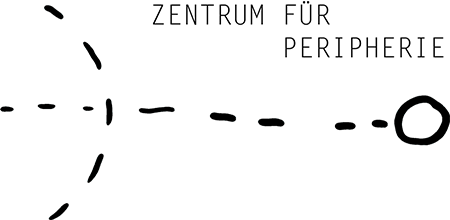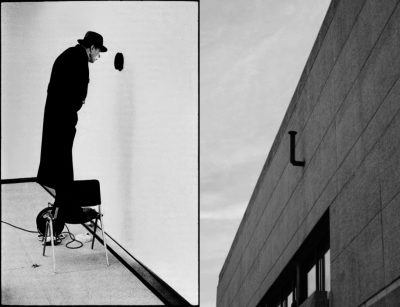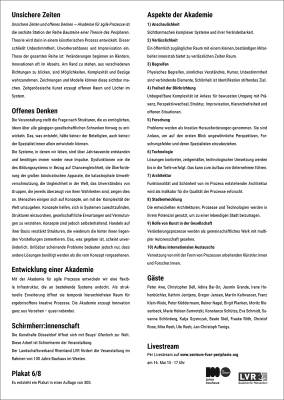Elements for a theory of periphery
Element #6 – Academy
Discussion at the Kunsthalle Düsseldorf on 16 May 2021.
The talk was streamed live.
Video of the discussion in the main hall of the Kunsthalle Düsseldorf (summary, 21:47 min).
Uncertain times
Uncertain times and open thinking | Academy for agile processes is the sixth station in the series Elements for a Theory of Periphery. Theory is developed in an artistic process. This includes indeterminacy, the unpredictable, and improvisation.
The thesis of the entire series is: changes begin at the margins, innovations often on the sidelines. Standing at the edge, outside, looking from different directions, are possibilities to perceive complexity and references and to make them visible. Contemporary art creates open space and holes in the system.
Left: Joseph Beuys in 1981 looking into the hole in a wall of the Kunsthalle Düsseldorf for the stovepipe installation, photo Ulrich Baatz; right, the stovepipe installation outside the Kunsthalle Dusseldorf, photo Benjamin Dodenhoff. (Source https://docplayer.org/96798791-Joseph-beuys-im-lenbachhaus-und-schenkung-lothar-schirmer.html, accessed 23.06.2021) The stovepipe is still in place today on the western outer wall of the Kunsthalle.
Open thinking
The event explores structures that make it possible to develop ideas across all the usual social barriers. What emerges could not have been developed by any of the participants or specialists alone.
The systems we live in have evolved over millennia and always need new impulses. Dysfunctions such as that of the education system in terms of unequal opportunities, the overburdening of the large bureaucratic apparatuses, the catastrophic environmental pollution, the inequality in the world, the lack of understanding between groups, each convinced of their truths, indicate this. People agree on concepts to deal with the complexity of the world. Concepts help to find one’s way in systems, to classify structures, to understand social expectations and assumptions. However, concepts are self-sustaining. Acting on their basis reinforces structures, which in turn cement the ideas behind them. What is given seems unchangeable. Problems that seem unsolvable initially only mean that solutions other than those envisaged by the respective concept are needed.
Poster #6/8, edition 300
Development of an academy
With the Academy for Agile Processes (AAP), we are developing a flexible infrastructure that docks onto existing systems. As a structural extension, it temporarily opens up hierarchy-free space for open-ended creative processes. The academy generates innovation quite by accident – virtually incidentally.
Aspects of the AAP
- Illustrativeness
Making complex systems and their changeability visible. - Reliability
A publicly accessible space with a small, consistent staff:ing offers space at reliable times. - Comprehension
Physical grasping, sensual understanding, humour, indeterminacy, are unifying elements, while beauty is the goal that creates identification. - Freedom of perspective
Incomprehensible complexity provides the occasion for a conscious approach to presence, change of perspective, structure, improvisation, freedom from hierarchy and emptiness. - Research
Problems are taken as creative challenges and as an opportunity to adopt perspectives that seem unusual at first glance, and to involve research fields and their specialists. - Technology
Solutions of concrete, contemporary, technological implementation are pursued in depth. From this, business development can ensue. - Architecture
Functionality and beauty of architecture created in the process shall be explored as an indicator of its quality. - Urban development
The developed architectures, processes and technologies are used in their potential to contribute to a vibrant city. - The role of art in society
Transformation processes are seen as a collaborative work with multiple authorship. - Building international exchange
Networking of artists and researchers working with the form of processes.
Guests
Peter Awe, Montessori School Wittenberge; Christopher Dell, Institute for Improvisation Technology Berlin; Jasmin Grande, Institute of Modernism in the Rhineland at Heinrich Heine University Düsseldorf; Kathrin Jentjens, Neue Auftraggeber; Franz Klein-Wiele, Head of the Workshop for Model and Prototype Construction at the University of Applied Sciences Düsseldorf; Peter Köddermann, Chairman der Baukultur NRW; Reiner Nagel, Chairman of the Bundesstftung Baukultur Potsdam: Birgit Planken, Montessori Gesamtschule Düsseldorf; Moritz Riesenbeck, student at the Kunstkademie Düsseldorf; Christof Rose, NRW Chamber of Architects; Frauke Röth, Büro Kosmos Potsdam; Eva Schmidt, curator Siegen; Susanna Schönberg, artist Cologne; Beate Steil, photographer Düsseldorf; Mira Reeh, student Kunstakademie Münster and HHU Düsseldorf; Ute Reeh, artist Düsseldorf; Jan-Christoph Tonigs, artistic director Kloster Bentlage and others.
Patronage
Kunsthalle Düsseldorf opens up to the world with Beuys’ Furnace Hole (an original installation in the Kunsthalle Düsseldorf). This work is the patron of the event.



